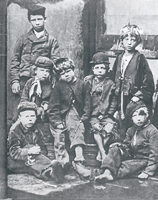In
the 1830ís the creation of the steam engine revolutionized manufacturing
and greatly reformed work in the USA. The steam engine led to steam powered
trains and steamboats, and let workers travel farther. Also, small farmers
started producing more than just substinence food, because the canals
let their crops be sold in a larger market.
The National Tradersí Union was formed by the workers in about 5 cities and was an attempt to create a national federation; this effort was ended by the panic of 1837. In 1835, children went on strike because they worked 11.5-hour days, for 6 days a week.
In 1863 a convention of farmers, mechanics and workmen took place in Utica NY and tried to convince them to increase the wage for labor.
In 1842 a Massachusetts Supreme Court ruling of Commonwealth vs. Hunt, they said that labor unions are not illegal conspiracies, and they also lowered the work hours for children to 10 hours. New Hampshire passes the first state law making the ten-hour day the legal workday. Eli Whitney created the cotton gin and this sped up the process of producing clean cotton. Interchangeable parts where a way to make production of machines easier. Such machines like John Deere use this technology.
Rhode Island System- it began when Samuel Slater enlisted entire families, including children, to work in his mills. These families often lived in company owned housing located near the mills, shopped at the company stores and attended company schools and churches.
The National Tradersí Union was formed by the workers in about 5 cities and was an attempt to create a national federation; this effort was ended by the panic of 1837. In 1835, children went on strike because they worked 11.5-hour days, for 6 days a week.
In 1863 a convention of farmers, mechanics and workmen took place in Utica NY and tried to convince them to increase the wage for labor.
In 1842 a Massachusetts Supreme Court ruling of Commonwealth vs. Hunt, they said that labor unions are not illegal conspiracies, and they also lowered the work hours for children to 10 hours. New Hampshire passes the first state law making the ten-hour day the legal workday. Eli Whitney created the cotton gin and this sped up the process of producing clean cotton. Interchangeable parts where a way to make production of machines easier. Such machines like John Deere use this technology.
Rhode Island System- it began when Samuel Slater enlisted entire families, including children, to work in his mills. These families often lived in company owned housing located near the mills, shopped at the company stores and attended company schools and churches.


Need more information?
Try the USDA educations site or the workers union timeline of events.